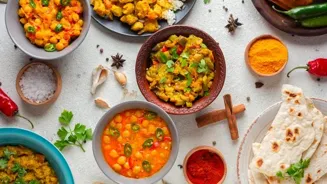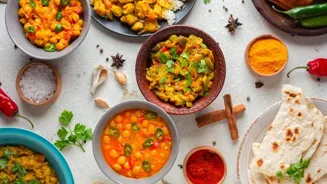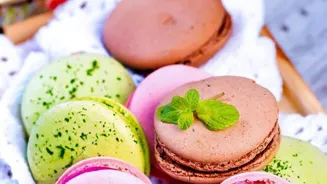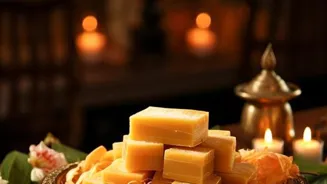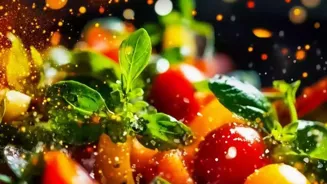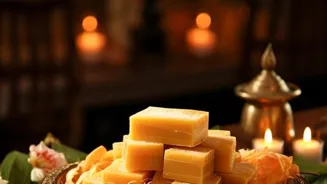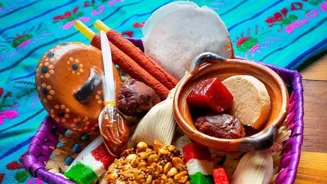Discover the Cultural Significance of Sweets in Indian Weddings: A Culinary Journey. Uncover the sweet symphony that enriches celebrations
Indian weddings, a grand spectacle of vibrant colours, elaborate
rituals, and joyous celebrations, are incomplete without the sweet symphony of mithai.
Sweets are not merely desserts; they are integral to the fabric of the wedding, symbolizing auspicious beginnings, prosperity, and the sweetness of a new life together for the couple.
Each region, each community, boast their signature sweets, adding a delectable layer of cultural richness to the wedding feast.
From the north's melt-in-your-mouth gulab jamuns to the south's creamy Mysore Pak, and the east's delightful rasgullas to the west's delicious modaks, the diversity of Indian sweets reflects the incredible culinary heritage of the country.
The preparation and distribution of these sweets are often steeped in tradition, making them an unforgettable part of the wedding experience.
Sweets symbolize joy in Indian wedding ceremonies
The distribution of sweets begins right from the roka ceremony, which marks the formal agreement between the families. Ladoo, a quintessential Indian sweet, often takes centre stage, signifying good fortune and new beginnings.
Following the roka, as the wedding festivities get underway, sweets play a central role in every ceremony. The engagement ceremony, with its exchange of rings and promises, is sweetened with barfi, peda, or other regional specialities.
The mehendi ceremony, where the bride's hands are adorned with intricate henna designs, is accompanied by the distribution of mithai to the guests, adding a sweet touch to the henna-filled atmosphere.
Similarly, during the sangeet, a night of music and dance, sweets are distributed to energise the dancing crowd and to make the night even more festive. The sweets serve as a reminder of the joyous occasion.
Sweets are integral in weddings, symbolizing happiness and prosperity
The wedding day itself is a grand affair, and sweets are an indispensable component of the wedding banquet.
The entrance of the groom is often greeted with sweets, and during the jaimala ceremony, when the bride and groom exchange garlands, sweets are distributed to the guests as a token of happiness.
After the wedding ceremony, the bride is welcomed into her new home with a traditional sweet dish, such as halwa or kheer, symbolizing the sweetness she is bringing into the family. This tradition signifies wishes for prosperity and happiness in the couple's new life together.
The bride tasting sweet after this is considered to be auspicious and it ensures that her life after marriage has all the sweets in life.
Diverse Indian wedding sweets: gulab jamun, rasmalai, jalebi, Mysore Pak, payasam, rasgulla, shrikhand, modak
The varieties of sweets offered at an Indian wedding are as diverse as the country itself. In North India, gulab jamun and rasmalai are always big hits.
Gulab jamun, deep-fried milk balls soaked in sugar syrup, are a crowd favorite, while rasmalai, flattened cheese patties soaked in sweetened, thickened milk, offer a creamy, refreshing experience.
Jalebi, a crispy, spiral-shaped sweet dipped in syrup, is another popular choice, especially during winter weddings. In South India, Mysore Pak, a rich, fudgy sweet made from gram flour, ghee, and sugar, is a must-have.
Payasam, a creamy rice pudding, is another significant sweet, often prepared with milk, sugar, nuts, and cardamom. The East offers delights like rasgulla and sandesh.
Rasgulla, spongy cheese balls soaked in syrup, are almost synonymous with Bengali cuisine, while sandesh, a sweet treat made from paneer, is known for its delicate flavour. Western India boasts sweets like shrikhand and modak.
Shrikhand, a creamy dessert made from hung curd, often flavoured with cardamom and saffron, is a refreshing treat.
Modak, a sweet dumpling made from rice flour and stuffed with coconut and jaggery, is especially famous in Maharashtra and considered the favorite sweet of Lord Ganesha, making it a prominent feature in wedding festivities.
Traditional sweets made with love, shared in community celebrations
The preparation methods of these sweets are often traditional and time-consuming, highlighting the love and care that go into making them. Many families have their own recipes passed down through generations, adding a personal touch to the wedding.
While some sweets are bought from professional sweet makers, many families prefer to make them at home, involving relatives and friends in the process. This collective effort adds to the sense of community and celebration.
The aroma of sweets being cooked fills the air, creating an atmosphere of anticipation and joy. The ingredients are carefully selected, and the recipes are followed meticulously to create the perfect blend of flavors.
The presentation is also given equal importance, with sweets often arranged in elaborate displays.
Sweets at Indian weddings symbolize love, prosperity, and family bonds, uniting and bringing joy to all
Beyond their delicious taste, sweets at Indian weddings carry a deep symbolic meaning. They represent the auspicious beginning of a new chapter in the lives of the bride and groom. They symbolize the sweetness of love, the hope for a prosperous future, and the strong bonds between families.
The sharing of sweets signifies goodwill and strengthens relationships. Every bite of mithai is a reminder of the joyous occasion and the blessings showered on the couple.
The role of sweets extends beyond mere culinary delight; they embody the cultural values and traditions that make Indian weddings so unique and memorable. They are an essential ingredient for a happy wedding and symbolize a happy and joyous life after as well. They add joy to the wedding.
They help bring people together.
AI Generated Content. Glance/InMobi shall have no liability for the content